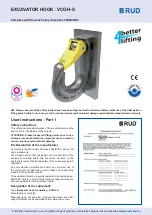
EXCAVATOR HOOK
-
VCGH-S
1.
Reference should be made to relevant standards and other
statutory regulations. Inspections should be carried out by
competent persons only.
2.
Before installing and at every use, visually inspect RUD
lifting points, with particular attention to any evidence of weld
cracks, corrosion, wear, deformations, etc.
3.
The material construction to which the lifting point will be
attached should be of adequate strength to withstand forces
during lifting without deformation. The contact areas must
be free from inpurities, oil, colour, etc. Preheat the structure
according to AS 1554 if required.
The Material of the welding plate is S355J2G3 (1.0577+N
(St52-3) ≈ AS3678 GR350.
4.
The lifting points must be positioned on the load in such a
way that movement is avoided during lifting.
a.) For single leg lifts, the lifting point should be vertically
above the centre of gravity of the load.
b.) For two leg lifts, the lifting points must be equidistant to/or
above the centre of gravity of the load.
c.) For three and four leg lifts, the lifting points should be arranged
symmetrically around the centre of gravity in the same plane.
5.
Load Symmetry: The working load limits of individual RUD
lifting points are calculated using the following formula and
are based on symmetrical loading:
NOTE: For WLL Calculations
• ß
angle is taken from the vertical plane.
• Included angle is the angle between the sling legs.
6.
The installation should be in the
direction of pull. Possible use area (see
right):
7.
All fittings connected to the VCGH-S
should be free moving. When connecting
and disconnecting the lifting means (sling
chain) pinches and impacts should be avoided. Damage of the
lifting means caused by sharp edges should also be avoided.
8.
Effect of temperature: During use in overheated areas the
WLL of the VABH-W has to be reduced according the chart:
-10° up to 200°C no reduction
200° up to 300°C minus 10% (392°F up to 572°F)
300° up to 400°C minus 25% (572°F up to 752°F)
Temperatures above 400°C (752°F) are not allowed.
User Instructions - Part 2
9.
The places where the lifting points are fixed should be
marked with colour.
10.
RUD-Lifting points must not be used under chemical
influences such as acids, alkaline solutions and vapours e.g.
in pickling baths or hot dip galvanising plants. If this cannot
avoided, please contact the manufacturer indicating the
concentration, period of penetration and temperature of use.
11.
If the lifting points are used exclusively for lashing the
value of the working load limit can be doubled.
LC = 2 x WLL
12.
After welding, an annual inspection or sooner if conditions
dicate should be undertaken by a competent person
examining the continued suitability. Also after damage and
special occurrences.
Inspection criteria regarding paragraphs 2 and 14:
•
The lifting point should be complete.
• The working load limit and manufacturers stamp should be
clearly visible.
• Deformation of the component parts such as body and load
ring.
• Mechanical damage, such as notches, particulary in high
stress areas.
• Wear should be no more than 10% of cross sectional
diameter.
•
Evidence of corrosion.
•
Evidence of cracks.
•
Cracks or other damages to the welding.
Any non-adherence to this advice may result in damages
of persons and/or materials!
W
LL
= required of lifting point/individual leg (kg)
G
= load weight (kg)
n
= number of load bearing legs
ß
= angle of inclination of the individual leg
W
LL =
G
n x cos ß





















